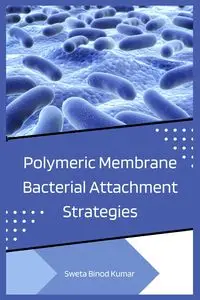Polymeric Membrane Bacterial Attachment Strategies - Kumar Sweta Binod
Polymeric membranes are extensively used in various applications such as water treatment, wastewater treatment, desalination, and other filtration processes. However, their performance is often compromised due to the attachment of bacteria on their surfaces, leading to biofouling and membrane fouling. Therefore, developing strategies to control bacterial attachment on polymeric membranes is crucial for maintaining their efficiency and longevity. In this book, Several Strategies have been explore to minimize bacterial attachment, including surface modifications to make the membranes more antifouling, self-cleaning, and resistant to biofilm formation.
These modifications can be achieved through the incorporation of hydrophilic, hydrophobic, or zwitterionic materials, as well as using nanotechnology-based methods. Biocides and disinfectants have also been used to prevent bacterial attachment, although their usage is limited due to environmental concerns.
Cleaning the membranes is also an important aspect of maintaining their performance. Membrane cleaning methods such as filtration, ultrafiltration, nanofiltration, and reverse osmosis can help remove bacteria and other contaminants from the membrane surface. However, frequent cleaning can also damage the membrane and reduce its lifespan, highlighting the need for fouling-resistant membranes.
Membrane bioreactors have emerged as a promising alternative to traditional wastewater treatment methods. In this process, biofilm formation on the membrane surface is encouraged to promote biodegradation of organic matter. Bio-inspired materials that mimic the surface charge, surface energy, and surface topography of biological organisms have also been developed to minimize bacterial adhesion. The attachment of bacteria on the membrane surface is influenced by various factors, including surface charge, surface energy, surface topography, microbial communities, and extracellular polymeric substances (EPS). Quorum sensing and other signaling mechanisms also play a critical role in the formation of biofilms.
Therefore, understanding the microbial ecology and physiology is crucial for developing effective strategies to control bacterial attachment. Overall, the control of bacterial attachment on polymeric membranes is a complex issue that requires a multidisciplinary approach. Strategies to prevent biofouling and membrane fouling should be developed while considering environmental impact, biodegradation, and the antimicrobial resistance of bacteria. The use of microbial adhesion and microbial physiology research can aid in the development of new strategies for effective bacterial attachment control.
EAN: 9785829157524
Oprawa Skórzana





